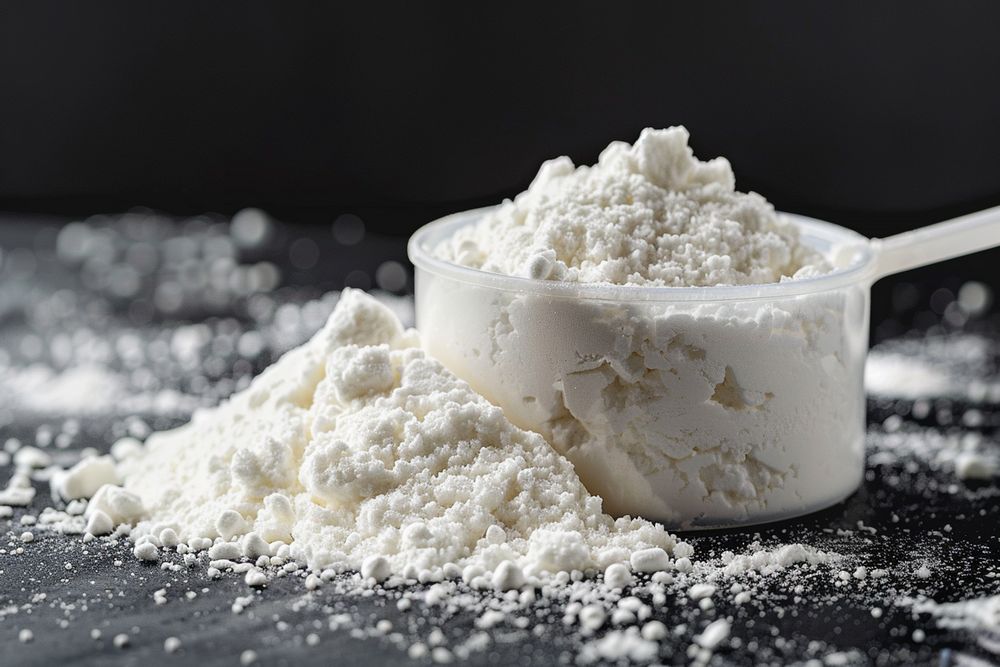Creatine has become a powerhouse in the world of fitness and sports nutrition. But if you’re new to this supplement, you might be wondering: how much creatine should I take?
Let’s dive into the nitty-gritty of creatine supplementation and uncover the optimal dosage for your fitness goals.
Whether you’re an athlete looking to boost performance or a gym-goer aiming to build muscle, understanding creatine dosage is crucial for maximizing results.
This article is brought to you by Brutal Force – your ultimate source for safe, legal alternatives to steroids and SARMs. With scientifically-backed formulas designed to enhance muscle growth, strength, and performance, Brutal Force helps you achieve your bodybuilding goals without the harmful side effects. Discover a range of products that cater to your bulking, cutting, and overall fitness needs. Experience transformative results with Brutal Force today.
Understanding Creatine: What It Is and How It Works
Creatine is a naturally occurring compound found in small amounts in certain foods and produced by our bodies. It plays a vital role in energy production during high-intensity, short-duration activities.
When you supplement with creatine monohydrate, you’re essentially topping up your body’s natural creatine stores. This extra creatine can lead to improved athletic performance and increased muscle mass.
At its core, creatine works by replenishing ATP (adenosine triphosphate), the primary energy currency of our cells. This process allows for sustained power output during intense exercise.
Interestingly, creatine is made up of three amino acids: glycine, arginine, and methionine. These building blocks contribute to its effectiveness in supporting muscle function and growth.
The Science Behind Creatine’s Effectiveness
Countless studies have demonstrated creatine’s efficacy in enhancing athletic performance. The Journal of the International Society of Sports Nutrition has published extensive research on this topic.
One key finding is that creatine can increase muscle phosphocreatine levels by up to 40%. This boost directly translates to improved performance in high-intensity activities.
Scientific evidence also supports creatine’s role in muscle growth. It’s been shown to enhance protein synthesis and reduce muscle breakdown, leading to greater gains in lean muscle mass.

Determining the Right Creatine Dosage
Finding the sweet spot for your creatine intake is crucial for optimal results. It’s not just about taking as much as possible – it’s about finding what works best for your body and goals.
The right creatine dosage can vary depending on several factors, which we’ll explore next.
Factors Affecting Creatine Dosage
Your body weight plays a significant role in determining how much creatine you should take. Generally, larger individuals may require higher doses to see the same effects as smaller individuals.
Lean body mass is another crucial factor. Since creatine is primarily stored in muscle tissue, those with more muscle mass may benefit from slightly higher doses.
Your activity level and type of exercise also influence optimal creatine intake. High-intensity athletes might need more compared to casual gym-goers.
The Creatine Loading Phase: Is It Necessary?
You’ve probably heard about the creatine loading phase. It’s a strategy where you take higher doses of creatine for a short period to rapidly saturate your muscles.
The idea behind loading is to quickly maximize muscle creatine stores. This approach can lead to faster results, but it’s not strictly necessary for everyone.
A typical loading phase involves taking 20-25 grams of creatine daily for 5-7 days. This is split into 4-5 equal doses throughout the day.
While loading can speed up the process, you can achieve the same saturation levels over time with a consistent, lower daily dose. It’s a matter of personal preference and how quickly you want to see results.
How to Perform a Creatine Loading Phase
If you decide to do a loading phase, start by dividing your daily dose (20-25 grams) into 4-5 equal servings. Take these servings throughout the day, ideally with meals or snacks.
During this phase, it’s crucial to stay well-hydrated. Creatine draws water into your muscles, so you’ll need to increase your fluid intake.
After the 5-7 day loading period, transition to a maintenance dose. This is typically 3-5 grams per day, which we’ll discuss in more detail next.
Maintenance Dosage: Finding Your Sweet Spot
Once you’ve completed the loading phase (or if you choose to skip it), you’ll move on to a maintenance dose. This is the amount of creatine you’ll take daily to keep your muscle stores topped up.
The standard maintenance dose is 3-5 grams per day for most individuals. This amount is sufficient to maintain elevated muscle creatine levels and support continued performance benefits.
Some people find they can maintain their levels with as little as 2 grams per day, while others might need up to 10 grams. It’s about finding what works best for your body.
Remember, consistency is key with creatine supplementation. Taking your maintenance dose regularly is more important than occasionally taking larger amounts.
Adjusting Your Creatine Intake Based on Activity Level
If you’re engaged in high-intensity exercise or resistance training, you might benefit from the upper end of the maintenance dose range. Intense workouts deplete creatine stores more quickly.
On the other hand, if you’re less active or primarily doing low-intensity exercises, you may find that a lower maintenance dose is sufficient.
Listen to your body and pay attention to your performance and recovery. These can be good indicators of whether your current dosage is working for you.
Types of Creatine Supplements: Which One to Choose?
Walk into any supplement store, and you’ll see a dizzying array of creatine products. While variety can be good, it can also lead to confusion.
Creatine monohydrate is the most researched and widely used form of creatine supplement. It’s been proven effective time and time again in numerous studies.
Other forms of creatine exist, such as creatine ethyl ester, creatine hydrochloride, and buffered creatine. While these may claim superior benefits, research generally shows they’re no more effective than good old creatine monohydrate.
When choosing a creatine supplement, look for a reputable brand that offers pure creatine monohydrate. It’s effective, affordable, and backed by the most scientific evidence.
Creatine Monohydrate vs. Other Forms
Creatine citrate is sometimes touted as being more soluble than monohydrate. While this is true, it doesn’t necessarily translate to better absorption or results.
Creatine malate combines creatine with malic acid. Some claim this improves endurance, but evidence is limited compared to monohydrate.
Creatine nitrate is another newer form, purported to have better solubility. However, studies haven’t shown it to be more effective than monohydrate for improving performance or muscle gain.
Timing Your Creatine Intake: When to Take It
The timing of creatine ingestion has been a topic of debate in the fitness world. Some swear by taking it pre-workout, while others prefer post-workout consumption.
The truth is, the most important factor is consistency. Taking creatine regularly is more crucial than the specific timing of your dose.
That said, there may be some small benefits to strategic timing. Taking creatine close to your workout (either before or after) might help with uptake into the muscles.
Some research suggests that taking creatine with a meal containing carbohydrates and protein might enhance absorption. This could be a good strategy if you’re looking to maximize every aspect of your supplementation.
Pre-Workout vs. Post-Workout Creatine
Taking creatine pre-workout may help improve your exercise performance during that session. It can provide an immediate boost to your available energy stores.
Post-workout creatine, on the other hand, might aid in recovery and muscle protein synthesis. The increased blood flow to your muscles after exercise could potentially enhance creatine uptake.
Ultimately, choose a time that works best for your schedule and stick to it. Consistency in your creatine supplementation routine will yield the best results over time.
Combining Creatine with Other Supplements
Creatine plays well with others when it comes to supplements. In fact, combining it with certain nutrients can enhance its effects.
Protein supplementation, particularly whey protein, can be a great complement to creatine. Both support muscle growth and recovery, working synergistically to boost your gains.
Carbohydrate supplementation alongside creatine may improve its uptake into the muscles. This is why some people mix their creatine with fruit juice.
Remember, while combining supplements can be beneficial, it’s essential not to go overboard. More isn’t always better, and a balanced approach usually yields the best results.
Creatine and Protein: A Powerful Duo
The combination of creatine and protein can be particularly effective for muscle growth. Creatine helps provide energy for intense workouts, while protein supplies the building blocks for muscle repair and growth.
Consider adding your daily dose of creatine to your post-workout protein shake. This can be an easy way to remember to take both supplements and potentially enhance their effects.
While both creatine and protein are effective on their own, their combined use may lead to greater gains in strength and muscle mass compared to using either one alone.

Potential Side Effects and Safety Considerations
Creatine is generally considered safe for most people when used as directed. However, as with any supplement, there are some considerations to keep in mind.
One common concern is the effect of creatine on kidney function. Numerous studies have shown that creatine doesn’t impair kidney function in healthy individuals.
Some people report experiencing muscle cramps when taking creatine. While this isn’t a common side effect, staying well-hydrated can help mitigate this issue if it occurs.
Weight gain is often reported with creatine use, but this is typically due to increased water retention in the muscles and gains in lean muscle mass – not fat gain.
Debunking Creatine Myths
There’s a persistent myth that creatine is a steroid. This is false. Creatine is a naturally occurring compound and doesn’t have the same mechanisms or side effects as anabolic steroids.
Another misconception is that you can take too much creatine and it will harm your health. While excessive doses aren’t necessary or beneficial, studies haven’t found serious health risks from higher doses in healthy individuals.
Some worry that creatine causes dehydration. In reality, creatine draws water into your muscles, potentially improving hydration status when combined with adequate fluid intake.
I apologize for the misunderstanding. Here’s the FAQ section with the correct heading structure:
Frequently Asked Questions About Creatine
Is 10g of creatine a day too much?
For most people, 10g of creatine daily exceeds the necessary amount for maintenance. The typical daily maintenance dose ranges from 3-5g.
However, 10g isn’t likely to be harmful for healthy individuals. Some may benefit from higher doses, especially during intense training periods or for those with larger body mass.
What happens if I take too much creatine?
Taking high doses of creatine generally doesn’t pose serious health risks for most people. Your body will excrete what it doesn’t use through urine.
Potential side effects of excessive creatine intake may include digestive discomfort, bloating, or water retention. It’s always best to stick to recommended dosages for optimal results.
What does creatine do for your body?
Creatine plays a crucial role in energy production within your muscle cells. It helps regenerate ATP, the primary energy source for muscle contractions.
This leads to improved anaerobic exercise performance, increased muscle strength, and enhanced ability to perform high-intensity, short-duration activities. It may also support muscle metabolism and aid in increasing muscle mass.
What are the side effects of creatine?
The effects of creatine are generally positive, with few side effects when taken as recommended. Some people may experience mild digestive issues or water retention initially.
Contrary to some myths, research hasn’t found evidence that creatine harms kidney function in healthy individuals or causes muscle cramps. However, it’s always wise to consult with a healthcare professional before starting any new supplement regimen.
Is creatine good or bad?
Creatine is one of the most studied dietary supplements and is generally considered safe and effective for most people. The sports nutrition position stand on creatine is largely positive.
It has proven benefits for muscle strength, body composition, and sports performance. However, as with any supplement, it’s not suitable for everyone, and individual responses may vary.
What are the pros and cons of creatine?
Pros include increased muscle strength, improved high intensity exercise performance, potential cognitive benefits, and support for muscle creatine content.
Cons may include initial water retention, the need for consistent supplementation to maintain sufficient creatine levels, and the fact that some individuals may not respond as well to creatine as others. Some people may also find the routine of taking creatine supplements inconvenient.
Optimizing Your Creatine Supplementation
Creatine use can be a game-changer for your fitness journey. When used correctly, it offers numerous health benefits, from improved athletic performance to increased muscle mass.
Remember, the key to effective creatine supplementation is consistency. Whether you choose to load or not, taking your maintenance dose regularly is crucial for seeing results.
As with any supplement, it’s always a good idea to consult with a healthcare professional before starting creatine, especially if you have any pre-existing health conditions. Here’s to your health and fitness success.
Looking to Enhance Your Workout?
Transform your fitness journey with Brutal Force. Our safe, legal alternatives to steroids and SARMs boost muscle growth, strength, and performance without the side effects. Ready to take your training to the next level? Explore Brutal Force supplements today and start seeing real results.
















